THE WOMAN IN BLACK
However, towards the end of the funeral, and on hearing some slight r...

English, 04.05.2020 22:49 clevens123
THE WOMAN IN BLACK
However, towards the end of the funeral, and on hearing some slight rustle behind me, I half-turned, discreetly and caught a glimpse of another mourner; a woman, who must have slipped into the church after we of the funeral party had taken our places and who stood several rows behind and quite alone, very erect and still, and not holding a prayer book. She was dressed in deepest black, in the style of full mourning that had rather gone out of fashion except, I imagined, in court circles on the most formal of occasions. Indeed, it had clearly been dug out of some old trunk or wardrobe, for its blackness was a little rust looking. A bonnet-type had covered her head and shaded her face, but, although I did not stare, even the swift glance I took of the woman showed me enough to recognise that she was suffering from some terrible wasting disease, for not only was she extremely pale, even more than a contrast with her black garments could account for, but the skin and, it seemed only the thinnest layer of flesh was tautly stretched and strained across her bones, so that it gleamed with a curious, blue-white sheen, and her eyes seemed sunken back into her head. Her hands that rested on the pew before her were in a similar state, as though she had been a victim of starvation.
Though not a medical expert, I had heard of certain conditions which caused such terrible wasting and ravages of the flesh, and knew that they were generally regarded as incurable, and it seemed poignant that a woman, who was perhaps only a short time from death, should drag herself to her funeral of another.
Following the parson and the coffin outside I soon realised that the unknown woman had slipped quickly away and gone out to the waiting open grave. Her appearance, even in the limpid sunshine and comparative warmth and brightness of the outdoors, was so pathetically wasted, so pale and gaunt with disease, that it should not have been a kindness to gaze upon her.
THE GRAVEYARD BOOK
There was a hand in the darkness, and it held a knife. The knife had a handle of polished black bone, and a blade finer and sharper than any razor. If it sliced you, you might not even know that you had been cut, not immediately.
The knife had done almost everything it was brought to that house to do, and both the blade and the handle were wet.
The street door was still open, just a little, where the knife and the man who held it had slipped in, and wisps of night-time mist slithered and twined into the house through the open door.
The man Jack paused on the landing. With his left hand he pulled a large white handkerchief from the pocket of his black coat, and with it he wiped off the knife and his gloved right hand which had been holding it; then he put the handkerchief away. The hunt was almost over. He had left the woman in her bed, the man on the bedroom floor, the older child in her brightly coloured bedroom, surrounded by toys and half finished models. That only left the little one, a baby barely a toddler, to take care of. One more and his task would be done.
He flexed his fingers. The man Jack was, above all things, a professional, or so he told himself, and he would not allowed himself to smile until the job was complete.
His hair was dark and his eyes were dark and he wore black leather gloves of the thinnest lambskin.
The toddler’s room was at the very top of the house.
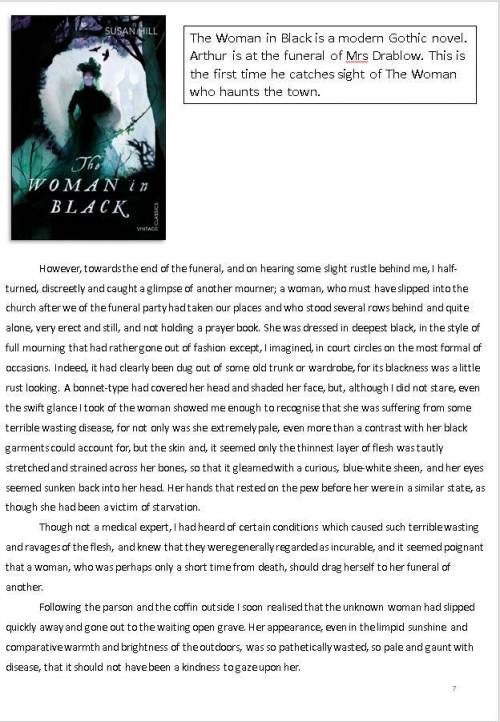
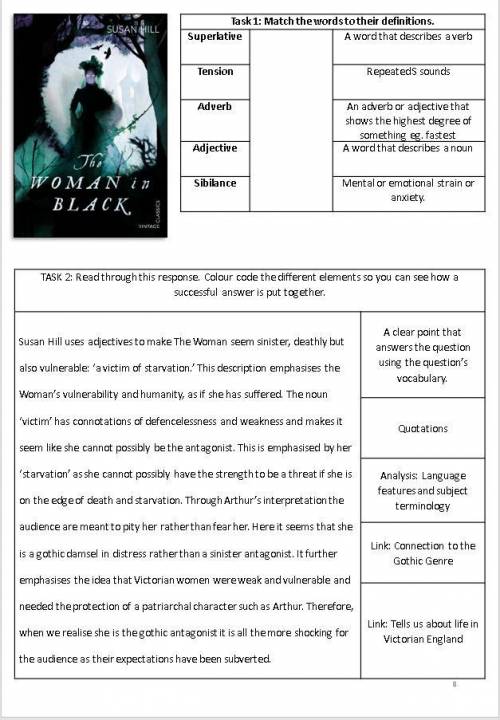
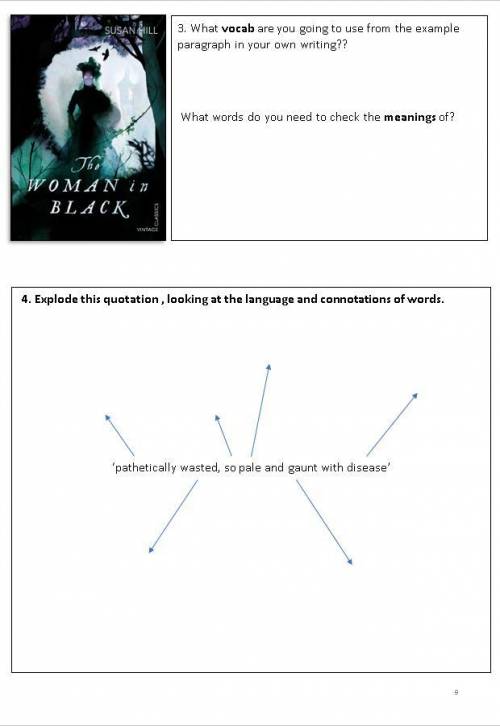
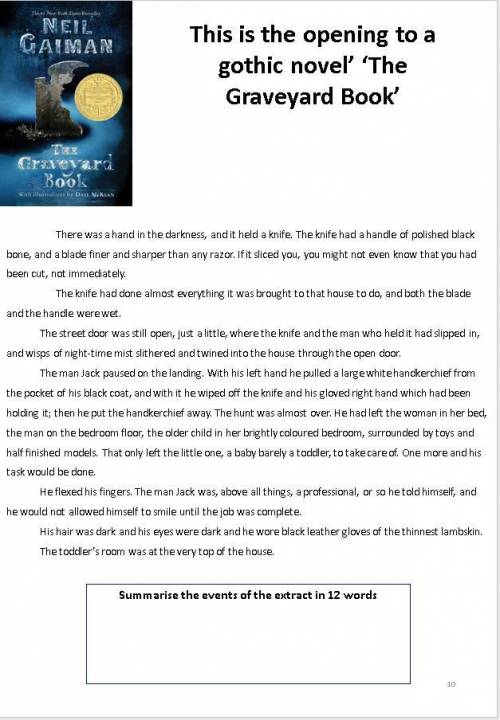
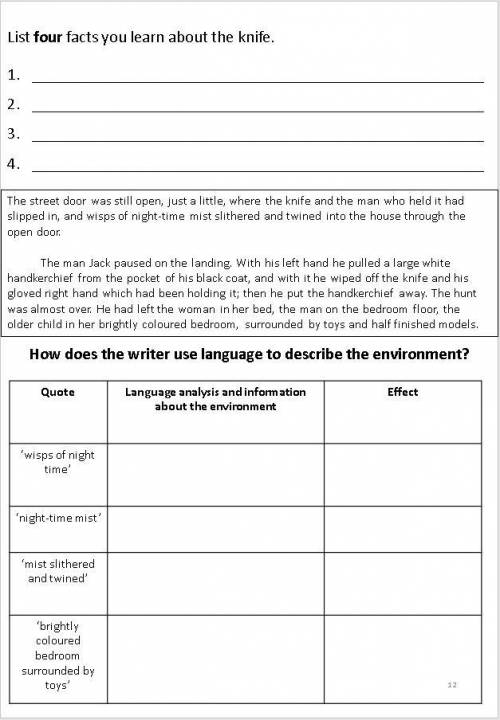

Answers: 3


Other questions on the subject: English

English, 22.06.2019 07:30, bankscorneliuso39
M read the sentence. what best describes the underlined part of the sentence, and why? alma plans to visit london and paris, where her parentswent on their first trip together as a married couple. it is a restrictive relative clause because it begins with arelative pronoun, has both a subject and a verb, and is notnecessary to the meaning of the sentence. it is a nonrestrictive relative clause because it begins witha relative pronoun, has both a subject and a verb, and isnecessary to the meaning of the sentence. it is a restrictive relative clause because it begins with arelative pronoun, has both a subject and a verb, and isnecessary to the meaning of the sentence. it is a nonrestrictive relative clause because it begins witha relative pronoun, has both a subject and a verb, and isnot necessary to the meaning of the sentence.
Answers: 2

English, 22.06.2019 08:30, MogTaee
Reflect on the passages above and your responses to them. compose a response to this questions: how does the use of metaphor bring to life or intensify whatever the author is describing? do you think metaphors enhance description or make them too difficult to understand? explain your response.
Answers: 3

English, 22.06.2019 10:00, mariahgriego4126
Which sentence is written correctly? a. it's too bad its raining, i wanted too go for a swim. b. its too bad its raining, i wanted to go for a swim. c. it's too bad it's raining, i wanted to go for a swim. d. it's to bad it's raining, i wanted too go for a swim.
Answers: 2

English, 22.06.2019 10:00, dontcareanyonemo
Determining a dependent clause as a part of speech choose the part of speech of the dependent clause in each sentence. whoever wants to is invited to come with us. talk to the person who is behind the counter. when i press the button, the computer starts up.
Answers: 2
You know the right answer?
Questions in other subjects:

Mathematics, 21.06.2019 14:30



Mathematics, 21.06.2019 14:30








